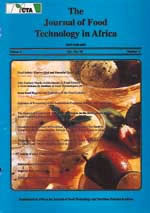
|
The Journal of Food Technology in Africa
Innovative Institutional Communications
ISSN: 1028-6098
Vol. 6, No. 3, 2001, pp. 101-103
|
 Bioline Code: ft01027
Bioline Code: ft01027
Full paper language: English
Document type: Research Article
Document available free of charge
|
|
|
The Journal of Food Technology in Africa, Vol. 6, No. 3, 2001, pp. 101-103
| en |
Changes in carbohydrate fractions of cassava peel following fungal solid state fermentation
Eustace A Iyayi and Dorothy M. Losel
Abstract
Cassava peels continue to constitute wastes in the cassava processing industry.
This is in spite of the potential of the by-product as an animal feedstuff.
Considerable evidence has emerged in recent times of the possibility of using
processed cassava peel as an energy source for pigs and poultry (Longe et
al, 1977; Tewe, 1981; Iyayi, 1986;). Higher inclusion of the by-product in
monogastric feed or formulation of diets with cassava peels, as sole energy
source is limited because of its fibrous nature. Fakolade (1977) and Arowora
et al (1999) have reported the occurrence of high amounts of non-starch
polysaccharides in cassava peels. Degradation of these carbohydrate compounds to
simple sugars will further increase the energy value of cassava peels. Since the
monogastric industry constitutes the largest consumer of commercial livestock
feeds in Africa, it is imperative to find alternative feed sources to the
expensive energy ingredients like the cereals. The enhancement of the nutritive
value of cassava peels by the use of fungi to break down the unavailable
carbohydrates in them is desirable and is the subject of this study.
|
| |
© Copyright 2001 The Journal of Food Technology in Africa, Nairobi
|
|
